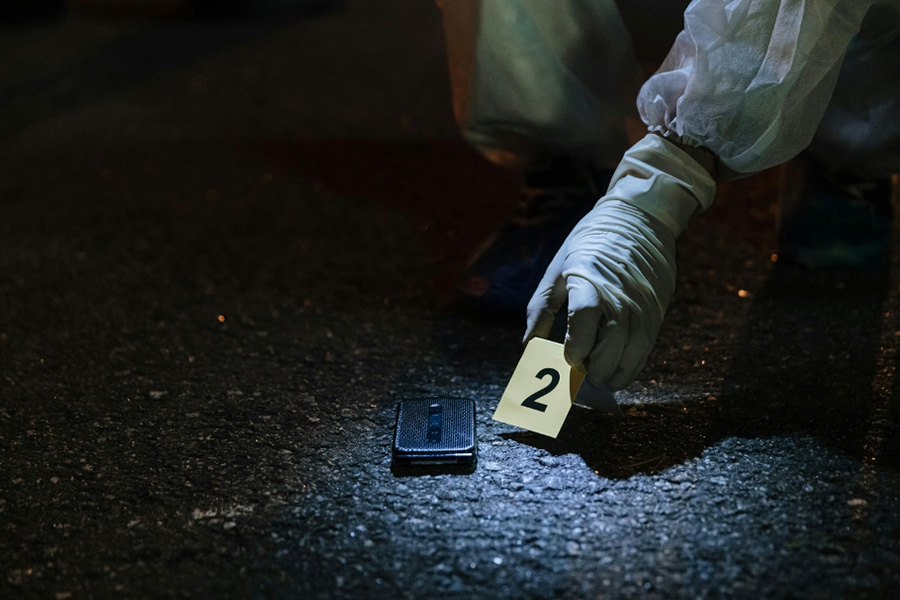The landscape of modern crime has evolved with the increasing ubiquity of digital technology. Today, digital evidence plays a crucial role in investigations across a vast spectrum of criminal activity, from cybercrime and fraud to homicide and child exploitation.
Recognizing the potential of digital evidence and understanding proper collection techniques are essential for law enforcement agencies and legal professionals seeking to build strong cases.
This blog explores various types of crime scenes and delves into the critical steps involved in collecting digital evidence effectively.
Understanding the Diverse Landscape of Crime Scenes
Crime scenes come in many forms, each requiring specialized investigative approaches. Here’s a breakdown of some common types:
1. Physical Crime Scenes:
These encompass traditional crime scenes like homicides, assaults, robberies, and burglaries. In such scenarios, digital evidence can be found on devices present at the scene, such as smartphones, computers, tablets, and even wearables.
2. Cybercrime Scenes:
This category encompasses crimes committed primarily within the digital realm, including data breaches, hacking incidents, online fraud, and child sexual abuse material (CSAM) distribution. Digital evidence, in these cases, often resides on servers, cloud storage platforms, and various digital devices used by the perpetrators.
3. Financial Crime Scenes:
White-collar crimes like embezzlement, money laundering, and securities fraud often leave a trail of digital evidence in the form of financial transactions, emails, and documents stored on computers and mobile devices.
Collecting Digital Evidence: A Meticulous Process
The collection of digital evidence requires a meticulous approach to ensure its integrity and admissibility in court. Here are the key steps involved:
1. Scene Identification and Securement: The Crucial First Steps
Scene identification and securing digital evidence form the foundation of a successful digital forensics investigation. Here’s a deeper dive into the two critical steps involved:
1. Identifying Potential Evidence:
The initial task involves recognizing all potential sources of digital evidence within the crime scene. This includes:
- Digital Devices: Smartphones, computers, tablets, laptops, wearables (smartwatches, fitness trackers), external hard drives, USB drives, and any other electronic devices present at the scene.
- Storage Media: Memory cards, SD cards, flash drives, and any other removable storage media that might contain relevant data.
- Network Devices: Routers, modems, and other network equipment that could hold information about internet activity and connections.
Importance of Recognizing Potential Evidence:

- Breadth of Digital Evidence: Modern technology integrates seamlessly into our lives, making digital evidence a potential component of almost any crime scene. Recognizing all possible sources is crucial to avoid overlooking crucial evidence.
- Data Volatility: Digital data is inherently volatile and can be easily altered or deleted. Prompt identification and securing devices minimize the risk of data loss or tampering.
2. Isolating and Securing Devices:
Once potential evidence is identified, the following steps are crucial:
- Powering Down Devices: This prevents further activity on the devices, safeguarding volatile data like RAM contents and potentially preventing self-destruct mechanisms.
- Physical Separation: Devices are physically disconnected from any network connections or other devices, further minimizing the risk of data alteration or contamination.
- Documenting Location: The exact location of each device within the crime scene is meticulously documented, including its position relative to other objects and potential witnesses. This information becomes crucial for reconstructing the events and identifying potential tampering attempts.
- Preventing Unauthorized Access: The crime scene is secured to prevent unauthorized individuals from handling or tampering with the devices. This may involve establishing a physical perimeter, employing security personnel, or both.
Importance of Proper Isolation and Securing:
- Preserving Evidence Integrity: By minimizing the risk of data alteration or contamination, the original state of the digital evidence is preserved, ensuring its admissibility in court.
- Chain of Custody: Establishing a clear chain of custody from the moment the evidence is identified until analysis begins is crucial for demonstrating its authenticity and preventing legal challenges.
2. Forensic Imaging:

Forensic imaging, also known as disk cloning, is the foundation for digital evidence analysis. It creates a bit-for-bit copy of the storage media, ensuring the original data remains unaltered:
Forensic Imaging Tools:
Specialized software like EnCase Forensic, FTK Imager, and Belkasoft X is used to create a precise replica of the storage media. These tools operate at the physical level, capturing every byte of data, including deleted files, unused space, and even hidden files that the operating system might bypass.
Write-Blocking Techniques:
To safeguard the integrity of the evidence, write-blocking techniques are employed. These techniques prevent any further writes to the original device. This ensures that the original data remains untouched, preventing accidental or malicious modifications that could compromise the evidence.
Multiple Copies:
Creating multiple copies of the forensic image serves two critical purposes:
Backup and Redundancy: Having multiple copies ensures a backup in case of accidental damage or data loss on one copy. This safeguards the integrity of the evidence even if unforeseen circumstances arise.
Chain of Custody Maintenance:
Maintaining multiple copies allows for independent analysis by different parties involved in the investigation, such as law enforcement agencies, legal teams, and potentially the defense. This strengthens the chain of custody and ensures transparency throughout the process.
3. Data Extraction and Analysis:
Once the forensic image is acquired, the investigation delves into the extracted data to uncover relevant evidence:
Data Extraction Tools:
Specialized software like Autopsy, Magnet Axiom, and X-Ways Forensics is used to extract relevant data from the forensic image. These tools can extract a wide range of digital artifacts, including:
Deleted Files:
Even files that have been deleted by the user can often be recovered through data carving techniques, which analyze the raw data on the storage media to identify remnants of deleted files.
Internet Browsing History:
Websites visited, search queries, and browsing history can provide valuable insights into the user’s online activity and potential criminal intent.
Communication Logs:
Call logs, emails, chat messages, and social media activity can reveal communication patterns, contacts, and potential accomplices.
Metadata:
Hidden data embedded within files, such as creation dates, modification times, and author information, can help establish timelines and identify potential tampering attempts.
Data Analysis Techniques:
Depending on the nature of the investigation, various analysis techniques are employed to extract meaningful information:
Keyword Searches:
Searching for specific keywords within the extracted data can quickly identify relevant files, emails, or documents containing incriminating information.
Data Carving:
As mentioned earlier, data carving techniques are used to recover deleted files and hidden data that might hold crucial evidence.
Timeline Reconstruction:
Analyzing timestamps and metadata associated with digital artifacts helps reconstruct the sequence of events and identify potential inconsistencies or suspicious activity.
Identifying Hidden Files:
Steganography techniques can be employed to uncover hidden files within seemingly innocuous images or documents, potentially revealing additional evidence.
4. Documentation and Chain of Custody:
Maintaining a meticulous record of the collection and analysis process is crucial for legal admissibility:
Detailed Records:
Comprehensive documentation includes the date and time of collection, the individuals involved, the specific actions performed on the evidence, and any software tools utilized.
Chain of Custody Forms:
Maintaining a chain of custody form ensures a clear and documented trail of who handled the evidence at each stage, from collection to analysis and presentation in court.
Preserving Evidence Integrity:
This meticulous documentation demonstrates that the evidence has been handled appropriately and not tampered with, ensuring its validity in legal proceedings.
Specific Considerations for Different Crime Scenes

While the core principles of digital evidence collection remain consistent across various crime scenes, certain nuances exist depending on the type of investigation:
1. Physical Crime Scenes:
In physical crime scenes, digital evidence often resides on devices present at the location, such as smartphones, computers, tablets, and even wearables. Here’s how investigators ensure its integrity:
Minimizing Contamination:
Accidental or deliberate contamination of devices is a major concern. Investigators wear gloves and use specialized tools to handle devices, avoiding touching sensitive areas like fingerprint scanners.
Preserving Scene Integrity:
The physical scene layout is crucial. Investigators document the location of each device relative to other objects and potential witnesses. This helps reconstruct the events and identify potential tampering attempts.
Powering Down Devices:
Immediately powering down devices prevents further data alteration or potential self-destruct mechanisms. This also safeguards volatile data like RAM contents, which can be crucial evidence.
Secure Packaging:
Devices are placed in anti-static bags and tamper-evident containers to prevent physical damage and unauthorized access during transportation to a secure forensic laboratory.
2. Cybercrime Scenes:
Cybercrime investigations often involve digital evidence residing in remote locations, such as servers, cloud storage platforms, or even personal devices located elsewhere. This necessitates additional considerations:
Identifying Relevant Locations:
Investigators need to pinpoint the specific digital locations where evidence might reside. This may involve analyzing network traffic logs, identifying compromised systems, and tracing online activity.
Legal Procedures:
Accessing and collecting evidence from remote locations often requires legal authorization. Investigators may need to obtain search warrants or collaborate with service providers to ensure legal compliance.
Preserving Volatile Data:
Certain digital evidence, like server logs or network traffic data, can be highly volatile and disappear quickly. Real-time collection techniques may be necessary to capture this transient evidence before it’s overwritten.
Data Preservation Techniques:
Once accessed, digital evidence from remote locations needs to be securely preserved. This may involve forensic imaging of server systems or downloading cloud storage data using specialized tools that maintain the chain of custody.
3. Financial Crime Scenes:

Financial crimes often involve complex financial transactions, emails, and documents stored on computers and mobile devices. Investigators need to focus on specific aspects of digital evidence collection:
Financial Transaction Tracking:
Forensic analysis of financial records involves tracing funds through complex networks, identifying hidden accounts, and uncovering money laundering activities. Specialized software and data analysis techniques are employed to reconstruct financial trials.
Email and Document Analysis:
Emails and documents can contain crucial evidence of intent, communication with co-conspirators, and financial agreements. Investigators meticulously examine these digital artifacts to identify relevant information and build the case.
Data Carving:
Deleted financial records or hidden files might still hold valuable evidence. Data carving techniques are used to recover deleted data from storage media, potentially revealing incriminating information.
International Cooperation:
Financial crimes often transcend national borders. Investigators may need to collaborate with international law enforcement agencies and financial institutions to collect evidence located in different countries.
The Role of Digital Forensics Experts
Digital forensics experts play a critical role in collecting, analyzing, and presenting digital evidence in a court-admissible format. These specialists possess the necessary expertise to:
- Utilize specialized tools and techniques for data recovery and analysis.
- Maintain a strict chain of custody and ensure the integrity of evidence.
- Interpret and present complex digital evidence in a clear and concise manner for legal proceedings.
- Act as computer forensics expert witness, providing testimony on the findings and methodology employed in the investigation.
Eclipse Forensics: Your Trusted Partner in Digital Evidence Collection

Eclipse Forensics offers a comprehensive suite of digital forensic services designed to assist law enforcement agencies and legal professionals in effectively collecting and analyzing digital evidence. Our team of experienced professionals leverages cutting-edge technology and adheres to the highest industry standards to ensure the integrity and admissibility of evidence in court.
We offer a range of services, including:
- Forensic data collection and imaging
- Mobile device forensics and data recovery
- Computer forensics and data analysis
- Forensic video analysis
- Forensic image redaction
- Expert witness testimony
Whether you are investigating a complex cybercrime, a financial fraud case, or a traditional physical crime with a digital component, Eclipse Forensics can provide the expertise and resources you need to secure and analyze critical digital evidence.
Contact Eclipse Forensics by calling (904) 797-1866) today to discuss your specific needs and learn how our digital forensic services can help you build a strong case.

